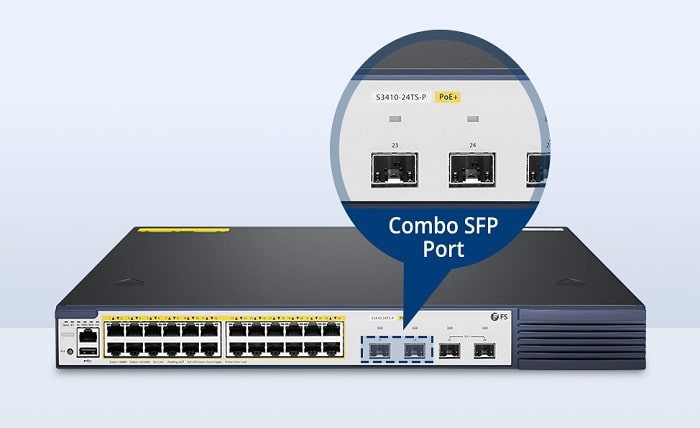Unlocking the Potential of SFP Ports on a Gigabit Switch

Small Form-factor Pluggable (SFP) ports on a Gigabit switch represent a highly flexible aspect of modern networking equipment, allowing network administrators to adapt network infrastructures to varied connectivity requirements. These ports support the insertion of various SFP modules, effectively enabling switches to interface with different media types, including both optical fiber and Ethernet. This capacity to interchange between different transmission standards without the need for replacing the whole device underlines the inherent adaptability and scalability of utilizing SFP ports in comprehensive network designs.View AscentOptics for More Details
What is an SFP Port and How Does It Enhance a Gigabit Switch?
Understanding the Role of Small Form-Factor Pluggable (SFP) in Networking
The Small Form-Factor Pluggable (SFP) port is a pivotal component in networking that facilitates the adaptability and scalability of network infrastructures. Serving as a compact, hot-pluggable interface, SFP ports enable network devices such as switches and routers to connect to a variety of external media types. This versatility is fundamental in accommodating the rapidly evolving requirements of modern networks, which may demand connections over different fiber optics or copper cabling depending on bandwidth, distance, and environmental factors.
The Advantages of Using SFP Ports on a Gigabit Switch
Incorporating SFP ports on a Gigabit switch introduces several significant advantages. Primarily, it allows for a more flexible network design that can easily adapt to changing connectivity needs, such as transitioning from copper to fiber optics to achieve longer range or higher bandwidth. Additionally, the ability to interchange SFP modules without replacing the entire switch apparatus results in considerable cost savings and reduces electronic waste. Furthermore, SFP ports support the deployment of link aggregation, enabling the bundling of multiple network connections for increased bandwidth and redundancy, thereby enhancing overall network performance and reliability. For more in-depth information you should view from AscentOptics SFP Ports
Differentiating SFP Switch and Gigabit Ethernet Switch
While both SFP switches and Gigabit Ethernet switches serve the purpose of interconnecting various network segments, the distinction lies in their flexibility and application scope. A Gigabit Ethernet switch primarily facilitates network connections using Gigabit Ethernet ports over copper cabling, suited for relatively short distances and lower bandwidth needs. In contrast, an SFP switch, equipped with SFP ports, supports a broader range of connectivity options, including both copper and fiber optic cables. This adaptability makes SFP switches inherently more versatile, capable of catering to diverse network configurations and performance requirements, especially in scenarios demanding high-speed data transmissions over extended distances.
Comparing SFP Port and RJ45 Port: Which One to Use?
Application Scenarios: When to Prefer One Over the Other
In the realm of networking, choosing between SFP ports and RJ45 ports depends significantly on the specific application scenarios, as each has its distinct advantages. For environments necessitating high-speed data transmission across considerable distances, fiber optic connections through SFP ports are unequivocally superior. These scenarios encompass data center interconnects, enterprise backbone networks, and metropolitan area networks (MANs), where the capacity to transport vast amounts of data quickly and reliably over long distances is paramount.
Conversely, in settings where cost-efficiency and short-range connectivity are predominant considerations, leveraging copper SFP modules or utilizing RJ45 ports for Gigabit Ethernet becomes more practical. This is particularly relevant in small to medium-sized business networks, localized office environments, and within data centers for short-range equipment connections. Here, the focus leans towards capitalizing on the existing copper cabling infrastructure to manage the network needs adequately without the necessity for the higher expense associated with fiber optics.
Understanding the technical contrast, operational efficiencies, and potential limitations of both SFP and RJ45 ports is crucial. This insight aids network designers and operators in making informed decisions, ensuring that the chosen connectivity approach aligns with both current requirements and future scalability prospects.If you are looking for more information about AscentOptics SFP Ports go here right away
Integrating Fiber Optic Technology: The Role of SFP in Fiber Networks
Connecting Distant Networks: The Use of SFP Fiber Modules
In the realm of high-speed data communication, the deployment of Small Form-factor Pluggable (SFP) fiber modules stands out for connecting distant networks efficiently. These modules, by nature, accommodate various fiber optic cable types, thereby offering versatility in network design and application. SFP modules, specifically designed for fiber networks, play a pivotal role in bridging long-distance communications between data centers, corporate offices, and beyond, effectively eliminating the limitations imposed by the attenuation of copper cables.
Fiber Optic Cable Types Compatible with SFP Modules
The adaptability of SFP modules extends to their compatibility with a broad spectrum of fiber optic cable types, including single-mode (SMF) and multimode fibers (MMF). Single-mode fibers, distinguished by their smaller core size, are ideally suited for long-distance communication, capable of transmitting data over kilometers without significant signal loss. Conversely, multimode fibers, with their larger core diameter, are tailored for shorter distances, offering high bandwidth over relatively compact network spans. This diversity allows network architects to select the most appropriate fiber type based on the specific distance, bandwidth, and budgetary requirements of the network.
Maximizing Bandwidth and Distance with Fiber SFP
The utilization of SFP fiber modules with the appropriate type of fiber optic cable is paramount for maximizing both bandwidth and transmission distance within a network. Whether integrating single-mode fibers to connect disparate data centers across vast distances or employing multimode fibers for high-bandwidth, short-range applications, the strategic deployment of SFP modules can significantly enhance network performance. This technology enables the construction of scalable, high-speed networks with the flexibility to meet evolving data communication needs, ensuring that organizations can maintain operational efficiency and competitiveness in an increasingly digital world.
Expanding Network Capacity with 10G SFP+ Ports and Modules
Transitioning to 10 Gbps: Benefits for Your Network
Advancing network capabilities to 10 Gbps using 10G SFP+ modules offers substantial benefits, including enhanced data throughput, reduced latency, and improved bandwidth per fiber. This leap in technology is not merely an upgrade but a necessary evolution to accommodate the exponentially growing data demands of modern organizations. It allows for smoother, faster data transmission, making it indispensable for applications requiring high-speed data access and real-time communication. Additionally, the integration of 10G SFP+ modules into existing network infrastructures empowers businesses to handle larger volumes of data more efficiently, facilitating advanced services and applications without compromising performance.
Compatibility and Installation of 10G SFP Modules
The 10G SFP+ modules are designed with backward compatibility in mind, enabling seamless integration into existing 1G networks while providing a clear path for future upgrades. The installation process of 10G SFP modules is straightforward, typically requiring no more than inserting the module into the available SFP+ port on the network equipment. This plug-and-play functionality ensures minimal downtime during network upgrades, making it easier for IT managers to enhance network capacity and performance without significant disruptions.
Choosing Between 1G SFP and 10G SFP+ for Future-Proofing Networks
When deliberating between 1G SFP and 10G SFP+ modules for network expansion or upgrades, it is crucial to consider both the current and anticipated data transmission requirements of the organization. While 1G SFP modules may suffice for smaller networks with moderate data traffic, opting for 10G SFP+ modules is a strategic move for future-proofing networks. This choice not only caters to current high-speed data needs but also accommodates future growth, ensuring that networks remain robust and responsive as data demands escalate. Investing in 10G SFP+ technology positions organizations to leverage faster and more reliable network performance, setting a solid foundation for navigating the digital landscape.
Understanding the Versatility of SFP Slots in Ethernet Switches
The Functionality of SFP Slots in Enhancing Connectivity
Small Form-factor Pluggable (SFP) slots in Ethernet switches serve as a critical component in network infrastructure, enhancing connectivity through their ability to accommodate a wide range of SFP transceiver modules. This versatility allows network architects to tailor connectivity based on specific requirements, such as fiber optic or copper links, and different speeds ranging from 1G to 10G, or more, ensuring that networks are optimized for both current and future needs. The strategic deployment of SFP slots in network design not only elevates the flexibility of network configurations but also significantly boosts the efficiency and scalability of network operations.
How to Use SFP Ports Effectively in Network Design
Using SFP ports effectively in network design involves a careful evaluation of the network’s current requirements and an anticipation of future demands. Begin by assessing the type of data traffic and bandwidth requirements of your network to determine the appropriate SFP modules (e.g., 1G SFP or 10G SFP+). Consider the types of media (e.g., fiber or copper) that will be utilized and the distances that need to be covered. Implementing SFP ports provides the agility to upgrade from copper to fiber links or from 1G to 10G speeds without replacing the entire switch, significantly reducing costs and increasing network longevity. Planning for spare SFP ports can also be wise, enabling quick expansions or modifications as needed without major overhaul.
Exploring the Different Types of SFP Ports and Their Uses
SFP ports are designed to accommodate a diverse range of SFP modules, each tailored for specific use cases. The most common types include:
- 1G SFP: Ideal for small to medium-sized networks with moderate data traffic, supporting both fiber and copper connections.
- 10G SFP+: Suited for larger networks with high data throughput demands, mainly using fiber optic connections to minimize latency and increase speed.
- BiDi SFP: Enables bidirectional communication over a single fiber, effectively doubling the capacity of existing infrastructure without additional cabling.
- CWDM/DWDM SFP: Used in metro Ethernet and long-haul networks, these modules support wavelength division multiplexing for significantly increased bandwidth over a single fiber optic cable.
Understanding the capabilities and applications of different SFP modules is essential for network designers and administrators looking to maximize connectivity, performance, and scalability of their networks.
Practical Guide to SFP Modules: Selection and Installation
Identifying the Right SFP Module for Your Network Requirements
Selecting the appropriate SFP module is contingent upon analyzing network requirements such as desired data rate, transmission distance, and the types of media (fiber or copper) being used. Factoring in the expansion plans for the network’s future can also guide the choice towards more adaptable modules like the 10G SFP+ for increasing bandwidth needs.
Step-by-Step Installation Process for SFP Modules
- Safety First: Ensure that you are properly grounded to prevent electrostatic discharge (ESD) damage to the SFP module.
- Inspect the Module and Port: Check the SFP module and the switch/router SFP port for any physical damage or debris.
- Module Insertion: Holding the SFP module by its sides, align it with the port and gently insert it until it clicks into place.
- Connecting the Cable: For fiber modules, connect the fiber optic cable to the SFP module. For copper SFPs, plug the RJ-45 connector into the module.
- Powering Up and Verification: Power on the device and verify the module’s functionality through the device’s administrative interface.
Maintaining and Troubleshooting Common SFP Connection Issues
Regular maintenance involves visually inspecting the SFP modules and cleaning the fiber optic connectors with appropriate tools to remove dust and dirt. Troubleshooting common issues such as connectivity loss or poor performance often starts with checking the physical integrity of the cables and connectors, followed by ensuring the correct configuration settings in the network device. Replacing suspect modules with known-good ones can quickly identify hardware failures.





